Apple MacBook Pro 13-inch with Retina Display Review
Apple MacBook Pro 13-inch with Retina Display
Apple's MacBook Pro 13-inch laptop has an amazing 2560 x 1600 retina display and superb build quality.
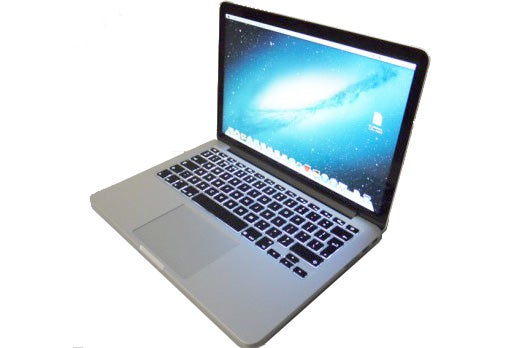
Verdict
Pros
- Superb high-res screen
- Excellent build quality
- Attractive design
- Powerful specs (aside from graphics)
Cons
- Expensive
- No dedicated graphics
- No Touch
- Decent but not great battery life
Key Specifications
- Review Price: £1449.00
- Aluminium unibody chassis
- 13in 2560 x 1600 IPS ‘Retina’ screen
- Up to Core i7, 8GB RAM, 768GB SSD
- Thunderbolt x 2, USB 3.0 x 2
MacBook Pro 13-inch with Retina Display – Introduction
The Apple MacBook Pro 15-inch with Retina Display is a superb laptop, but for some it’s just a little too big and heavy. Until recently Apple didn’t offer a solution, but now the iPad is not the only thing it’s shrinking: welcome to the MacBook Pro 13-inch with Retina Display.
It made sense to introduce a 15-inch laptop with its by now signature high-res IPS displays first, as that is still the most popular laptop size. However, 13-inch ultraportables are on the rise, and the new MacBook Pro 13-inch Retina should satisfy the cravings of those who prefer the MacBook Air’s portability yet want more power and a better screen than it can deliver.
SEE ALSO: Best Laptops, Ultrabooks and Hybrids
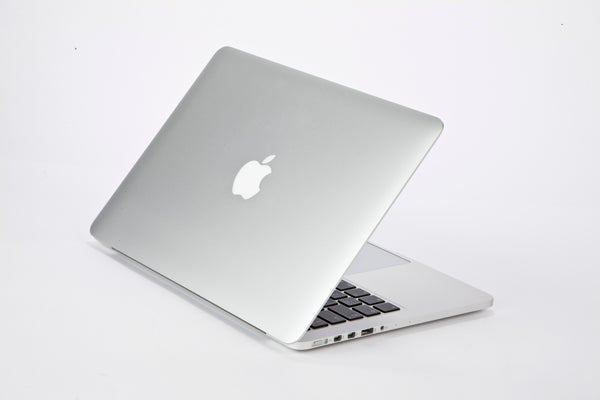
Like its bigger brother, the MacBook Pro 13-inch Retina sports a third-gen Intel processor backed by 8GB of RAM and several SSD options. It does notch the resolution down just a tad, to a still awesome 2,560 x 1,600, which is more than professional 27-inch monitors like the ViewSonic VP2770-LED offer, and you can’t go quad-core for the CPU – but for many, neither of these will be issues.
The only thing you’re really missing out on compared to this MacBook’s larger sibling is Nvidia’s 600-series dedicated graphics, which you would definitely expect as an option to drive all those pixels. As Intel’s HD 4000 can barely cope with 3D gaming at standard resolutions, there’s little hope of running anything remotely demanding in Retina goodness, while GPU acceleration in programs like Photoshop won’t make much of an impression either – and when you’re paying over £1,400 for a laptop, you might reasonably expect its graphics to be at least decent.
Related: Apple MacBook Pro 2016: Everything you need to know
MacBook Pro 13-inch Retina Design
Apple’s MacBook Pro range has always been attractive, but the fruity company took things a step further with the Pro 15-inch with Retina, slimming its relatively chunky professional laptop line down further and giving it a more streamlined, unibody design – though this does mean that upgrading and battery swapping are now off the menu.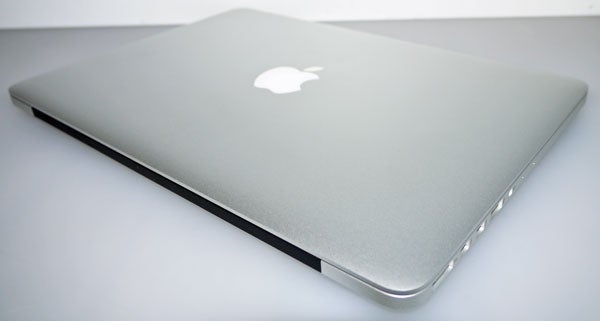
The MacBook Pro 13-inch with Retina is essentially a smaller version of the 15-inch Retina MacBook, and that’s no bad thing. Despite powerful rivals like the Dell XPS 14 looking pretty swank in their own right, there’s still little that can touch the MacBook with Retina for sheer minimalist style.
Build quality is concurrently excellent. The Pro’s unibody aluminium chassis is as solid as they come, the hinge is strong yet offers smooth action, and nowhere is there a hint of flex or creak.
The devil is in the details, and Apple can afford to engineer the heck out of its laptops. Even little touches like the revised MagSafe 2 magnetic charging plug which you can insert either way around (downside up or upside down) add to the feeling of overall quality.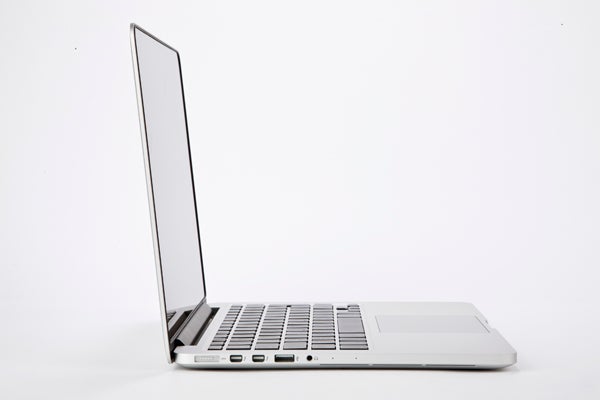
Though it’s no tapering Air, the 13-inch MacBook Pro still manages to be reasonably light at 1.6kg (compared to 2kg for the 15-inch model, and 1.35kg for the Air). Bizarrely though, the larger MacBook Pro is actually thinner, at 18mm compared to the 13-inch version’s 19mm.
MacBook Pro 13-inch Retina Connectivity
Apple upped the connectivity ante on its latest ultraportable laptops with the MacBook Air 13-inch 2012, by finally including USB 3.0 along with the cutting-edge – but not yet widely supported – Thunderbolt port.
The 13-inch Pro with Retina goes one better by maintaining the dual Thunderbolt and dual USB 3.0 connections that the 15-inch version sports. This makes it, quite simply, the best-connected 13-inch laptop in the world bar none. The notable absentees here are 3G/4G and an Ethernet jack, though of course (as with every laptop) adapters are available that will add both. 
So on the left you’ll find the MagSafe 2 socket, dual Thunderbolt ports which share a connector with the mini DisplayPort standard, a single USB 3.0 socket, and a headphone/microphone jack. The right houses an SDXC card slot, full-size HDMI port, and the second USB 3.0 port. On the wireless front, meanwhile, Wi-Fi and Bluetooth 4.0 are present but, as mentioned, mobile broadband is not an option.
Prefer a Windows 8 laptop or convertible with touch? Have a read of our Best Windows 8 Laptops, Tablets, Convertibles and PCs Roundup
MacBook Pro 13-inch Retina Keyboard
Once again, Apple hasn’t fixed what wasn’t broken for the 13-inch version of its Retina laptops. Its keyboard and touchpad are basically a smaller version of those found on the Apple MacBook Pro 15-inch with Retina Display, and that’s general a good thing.
The Chiclet/isolation keyboard sports a great layout with well-spaced keys. Feedback is also good, with crisp action and plenty of travel. To top things off, the keyboard is nicely backlit in white. 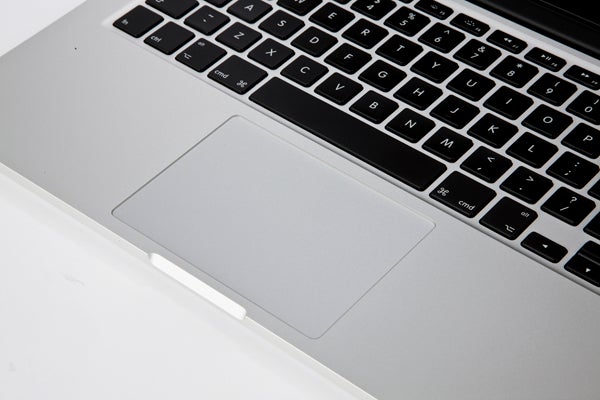
However, while the 13-inch MacBook Pro Retina offers a great typing experience, it’s not without a few minor niggles. First off, all that metal under your palms can be very chilly (read: freezing) if you’ve been carrying the laptop outside in winter weather. This is something Dell gets around by using softer magnesium alloy for the metal palm-rests of its premium laptops.
Secondly – depending on the position of your mitts while typing – the sharp edge of the chassis just under the palm rest may make things a little uncomfortable. Even were these issues addressed, we would still prefer the curved keys and deeper travel of the Lenovo ThinkPad X1 Carbon.
MacBook Pro 13-inch Retina Touchpad
We have absolutely no complaints about the button-less touchpad though. Its glass surface feels great under your fingertips, it’s sensitive but doesn’t usually pick up accidental movements, and gestures are beautifully integrated into MacOS (though Windows 8 has finally caught up here).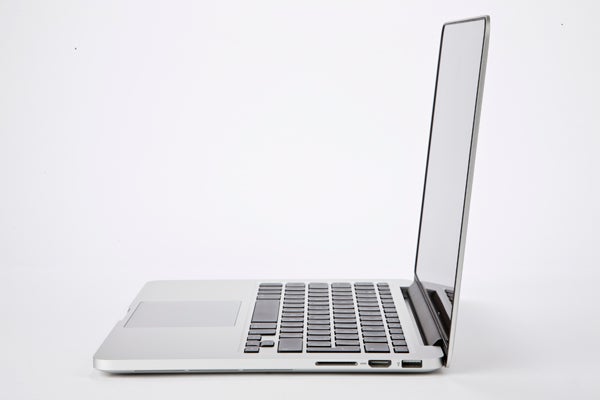
MacBook Pro 13-inch Retina Touch
The one advantage that most premium Windows 8 machines automatically offer over Apple’s laptops is touchscreens. While initially we were sceptical of the utility of touch on a regular laptop, after playing with a few for an extended while we really wouldn’t want to go back, and in fact often found ourselves poking ineffectually at the MacBook’s screen.
It’s ironic that Apple, the company which made touch the main interaction method on mobile devices from phones to tablets, so stubbornly resists it in the laptop space. Windows 8, on the other hand, pretty much requires touch to get the most out of it – something to keep in mind if installing Microsoft’s OS alongside MacOS X.
MacBook Pro 13-inch Retina Display
The new MacBook Pro 13-inch will have what Apple calls a Retina display. All this means is that it’s very high resolution, something Sony (and others) have been doing with their laptops for years. However, the 13-inch Retina’s resolution sets a new benchmark, packing in a whopping 2,560 x 1,600 pixels. As mentioned, that’s a higher resolution than a premium 27-inch monitor.
This gives the MacBook Pro 13-inch Retina Display a PPI (pixels per inch) count of around 227, higher than the Apple MacBook Pro 15-inch with Retina Display and only slightly lower than the 264ppi of the iPad 3 and 4.
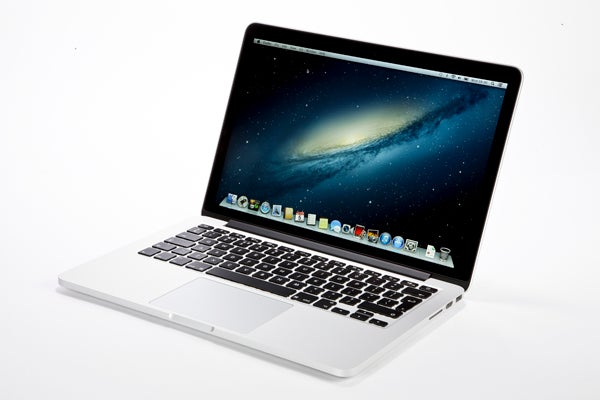
Not only is everything incredibly sharp with nary a pixel to be seen, but because the panel is of the IPS rather than TN variety, viewing angles are also as close to perfect as laptops get. Combined with Apple’s usual attention to detail when it comes to colour accuracy and backlight evenness, the MacBook Pro 13-inch Retina quite simply has the best screen of any ultraportable laptop available.
If we’re being particularly picky there’s the slightest hint of backlight clouding, but really our only complaint with the MacBook Pro 13-inch Retina’s screen is that though blacks are lovely and deep, out-of-box settings mean some dark detail is lost.
MacBook Pro 13-inch Retina Speakers
On the audio side of things the 13-inch Retina MacBook Pro holds up well. Its speakers manage a decent volume level and reasonable clarity, though as usual for this size laptop bass is lacking. We’d happily watch a light movie on the 13-inch Retina, though anything more dramatic will still want some headphones.
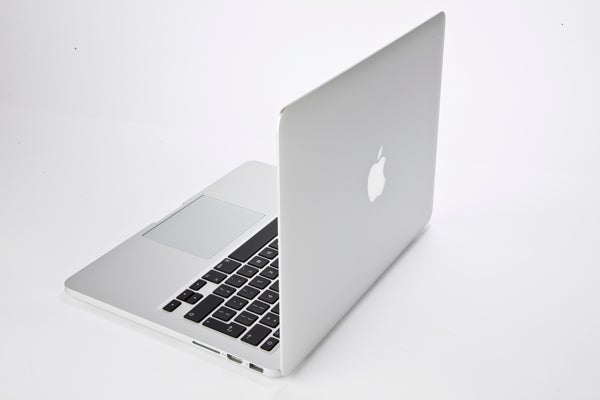
MacBook Pro 13-inch Retina Specs
As you would expect on a high-end laptop aimed as much at content creation as consumption, the 13-inch MacBook Pro with Retina gives you a choice of the latest-gen Intel Core i5 or i7 processors.
As mentioned before, the only downside compared to Apple’s 15-inch Pro with Retina is that there is no quad-core option. Our review sample came with the ‘base-line’ Core i5-3210M, which runs at 2.5GHz by default and can turbo clock up to 3.1GHz. The CPU is backed by a generous 8GB of RAM as standard, which should be plenty for most. In fact it had better be, as you can’t upgrade to 16GB like with the 15-inch with Retina Display.
(u)PCMark 07(/u)
General: 4603
Entertainment: 3443
One area where the 13-inch Pro doesn’t lose out to its bigger brother is in storage. Though it starts off with a smaller 128GB minimum (compared to 256GB on the 15-inch MacBook Pro with Retina), both laptops can be upgraded to a whopping 768GB SSD. On the base 13-inch model, this will ‘only’ set you back £1,050. Yep, that’s not a typo. Obviously, we wouldn’t generally recommend this upgrade, and even £650 for the 512GB upgrade is expensive enough that we would think hard about external storage solutions when buying this machine.
Graphics is probably the weakest weapon in the latest MacBook Pro with Retina’s arsenal. Unlike the 15-inch version with its Nvidia ‘Keppler’ GeForce GT 650M on every model, with the 13-inch Pro you’re stuck with Intel’s integrated HD 4000.
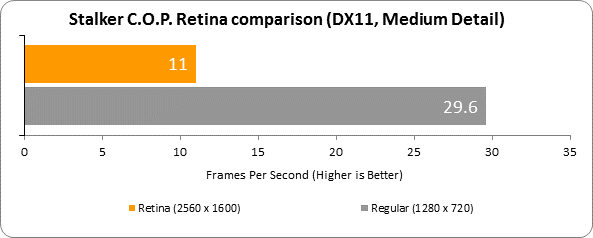
Trying to run any recent 3D game at the display’s insanely high resolution will result in a horrible slideshow, though older titles may still be playable if you go easy on the detail – as demonstrated by a reasonable 41fps average in TrackMania at 2,560 x 1,600. However, for more demanding games we’ll let the graph speak for itself. If you want to game on a portable Mac system, get the 15-inch Pro with its Nvidia graphics.
As an upside to the lack of dedicated graphics, the MacBook Pro 13-inch Retina never became as noisy or hot to the touch as the 15-incher, which could get positively toasty near the hinge while gaming.
Retina MacBook Pro 13-inch – Battery
One of the disadvantages of slimming laptops down is that there’s less room for the battery, and in the Retina versions of the MacBook Pros they’re also no longer removable. However, this 13-inch laptop still manages to hold its own.
Running at its native 2,560 x 1,600 resolution, the 13-inch MacBook Pro with Retina Display lasted 5 hours and 46 minutes away from a socket (keep in mind this figure would have been even higher using our previous, lighter battery benchmark). Turning screen brightness down below the 40 percent test figure would also result in longer battery life, so with careful use Apple’s claimed seven-hour figure should be easy to achieve.
Retina MacBook Pro 13-inch – Price
Before we dive deeper into the value this laptop represents, it’s worth pointing out that you are getting a superbly designed and built machine for your money with the best 13-inch screen out there; but at the same time, it’s not without compromises and there are plenty of alternatives for this much cash. Our main complaint is that Apple wasn’t able to fit in a dedicated graphics card, which for many power users will make Apple’s own MacBook Pro 15-inch with Retina Display the better buy.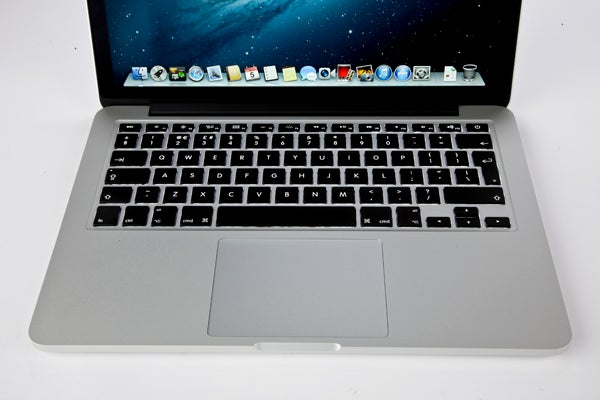
But let’s compare to a few direct rivals for the £1,450 base configuration of our MacBook Pro 13-inch with Retina. First off there’s the Zenbook Prime 13-inch. In its £1,440 incarnation this sleek Ultrabook is thinner and lighter than the Pro, doubles its SSD storage, and comes with a faster Core i7 processor by default. On the other hand, its RAM is halved, its Full HD IPS screen obviously doesn’t sport as many pixels (not that you’d need more in a 13-inch screen, really), and neither connectivity nor battery life measure up. So it’s a case of what your priorities are, but we’d probably go Apple here despite the extra weight.
Another rival is the Sony VAIO S13. For around £1,500, you get the same processor and RAM, double the SSD space, a Blu-ray drive, and dedicated Nvidia GT640M graphics, plus Adobe’s Photoshop Elements software. However, its screen uses an inferior TN panel whose resolution is ‘only’ 1,600 x 900, and it’s nowhere near as stylish. 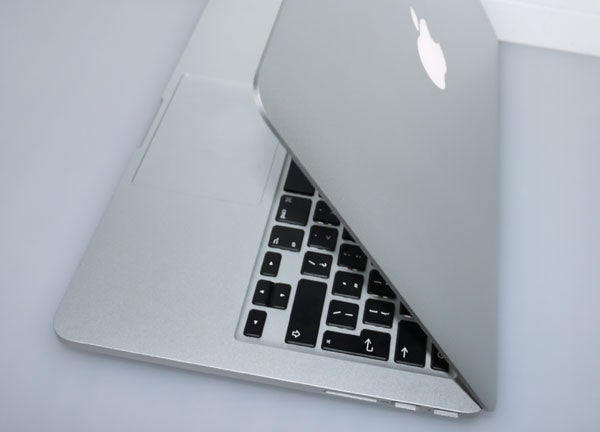
Either way, it shows that the Retina MacBook Pro 13-inch is not particularly overpriced. That’s not to say you can’t get some pretty great alternatives for this kind of money though, and ever more of them will offer something none of Apple’s laptops do: touch.
For example, the 13-inch version of the Acer Aspire S7 gives you all the specs of the Zenbook Prime including a gorgeous 1080p IPS screen, but also throws in 10-point touch to make the most of Windows 8. Considering it nearly rivals the MacBook Pro for style too, its £1,360-odd price makes it a very interesting alternative. 
And soon it will be joined by a whole bunch of Windows 8 laptops and convertibles offering touch, pressure-sensitive styli, tablet functionality, and potentially far longer battery life. Keep an eye on our Best Windows 8 Laptops, Tablets, Convertibles and PCs Roundup for all the latest.
MacBook Pro 13-inch with Retina Display – Verdict
Apple’s MacBook Pro 13-inch with Retina Display is a worthy smaller sibling to the earlier 15-inch version, bringing the MacBook Pro and Air lines closer together than ever with its gorgeous, sleek chassis. It’s beautifully crafted, offers great ergonomics, and its ‘Retina’ screen is simply superb. Even connectivity is superior to that offered by most ultraportable laptops. However, its battery life is merely on the good side of average; it doesn’t match the power of its other components and that beautiful screen with a decent graphics solution; and its high price means there are plenty of rivals which offer more features – sometimes even for less money. In other words, you probably won’t regret buying it, but make sure an alternative doesn’t suit your needs better.
How we test laptops
Unlike other sites, we test every laptop we review thoroughly over an extended period of time. We use industry standard tests to compare features properly. We’ll always tell you what we find. We never, ever, accept money to review a product.
Trusted Score
Score in detail
-
Performance 8
-
Design 10
-
Screen Quality 10
-
Value 7
-
Features 8
-
Battery Life 7

